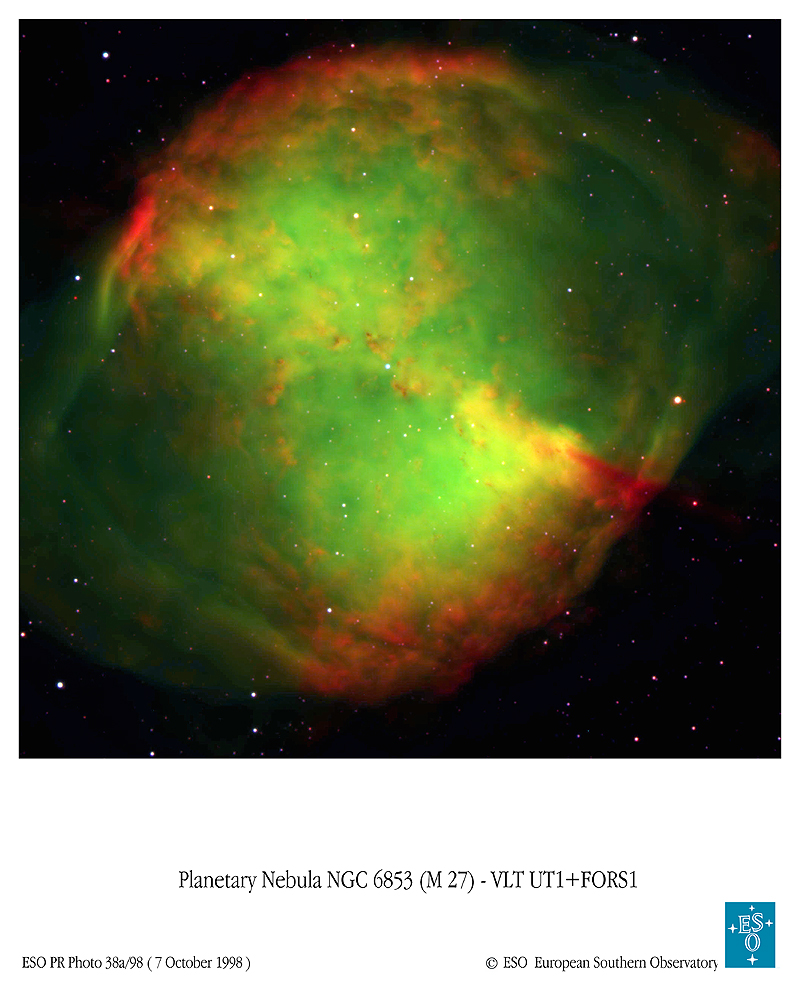







| BOOKS | F. A. Q. | ARTICLES | TALKS | ABOUT KEN | DONATE | BEYOND OUR KEN |
|---|

Image by the European Southern Observatory's Very Large Telescope.
Text by Ken Croswell
Published in Astronomy (September 2005, page 44).
All you eat, drink, and breathe contains atoms forged in distant massive stars that exploded as supernovae. But one vital element--nitrogen--entered space gently, when less massive suns cast it off in planetary nebulae.
A stunning example decorates the summer sky in the constellation Vulpecula. Although it bears an odd name, the Dumbbell Nebula (M27) resembles a beautiful Christmas ornament. Parallax data from the Hubble Space Telescope indicate itís 1,400 light-years from Earth and 2.1 light-years across along the yellow axis that runs from 10 to 4 oíclock. If the Dumbbell Nebula surrounded the Sun, it would stretch a quarter of the way to Alpha Centauri--the nearest star system to the Sun.
The Dumbbell marks the spot where an aging red giant star cast its atmosphere into space and exposed its core. The coreís diameter is only 6 times that of Earth, but itís so hot--110,000 Kelvin versus the Sunís 5,800 K--that itís bright enough to see in this image.
Because of the starís high temperature, it emits ultraviolet radiation that sets the gas aglow, creating a collage of green, yellow, and red. The dominant color, green, comes from oxygen; but most of the gas is hydrogen, which contributes some of the red. Where the green and red mix, they make yellow.
Oxygen and hydrogen are vital for life, but neither arose in planetary nebulae. Instead, the oxygen came from stars that exploded, while the hydrogen emerged from the big bang.
Nevertheless, the quiet suns that produce planetary nebulae have contributed more than 90 percent of the universeís supply of another life-giving element, nitrogen. This element constitutes an essential part of protein and makes up 78 percent of Earthís atmosphere. With every breath, you inhale the offerings of innumerable planetary nebulae.
Thanks to the stars that produce these nebulae, nitrogen is the sixth most abundant element in the cosmos, after hydrogen, helium, oxygen, carbon, and neon.
The star that created the Dumbbell Nebula certainly did its share. The Dumbbell has two to three times the Sunís nitrogen-to-hydrogen ratio. Nitrogen, like hydrogen, glows red, accounting for some of the red color in this image. The star also created another crucial element, carbon. The Dumbbell has twice the solar carbon-to-hydrogen ratio.
The Dumbbell Nebulaís progenitor star was born with several times the Sunís mass. The Sun itself is destined to swell into a red giant 7 billion years from now and then shed its atmosphere. Because of its lesser mass, though, the Sun will offer no new carbon; however, it will contribute a small amount of helium and nitrogen.
The Sunís cast-off elements will swirl around the Milky Way Galaxy. Some will enter interstellar clouds giving birth to new stars and planets. Calculations suggest the Sunís newly minted nitrogen could endow roughly 100 million terrestrial planets with atmospheres like our own. Thus, even after it dies, the Sun, which now supports life on Earth, may continue to do the same on other planets.
Update (September 23, 2009): Further data from the Hubble Space Telescope indicates the distance of the Dumbbell Nebula is 1,320 light-years, with an uncertainty of about 90 light-years. The diameter of the central star is 4.5 percent that of the Sun, or about 5 times the Earth's diameter.
Ken Croswell is an astronomer in Berkeley, California, and the author of Magnificent Universe.
"Elegant and eloquent"--Washington Post. See all reviews of Magnificent Universe here.
| BOOKS | F. A. Q. | ARTICLES | TALKS | ABOUT KEN | DONATE | BEYOND OUR KEN |
|---|